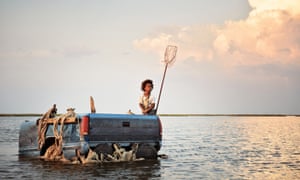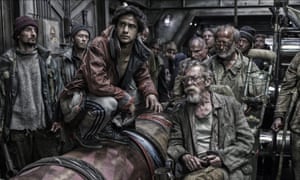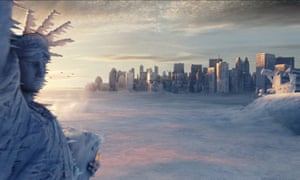Spoiler alerts: the
five best climate-change films
https://www.theguardian.com/environment/2017/jan/18/best-top-climate-change-films
“We know that it was us that scorched the sky.”
And with that curt footnote, The Matrix sidesteps any further elaboration on the climate conditions that reign in the future outside the virtual world. Which seems to be Hollywood’s approach to climate change all over. It’s great for a bit of post-apocalyptic window-dressing, but any serious consideration of the topic is almost taboo. Perhaps the eco-scepticism of middle America – still Hollywood’s main market – is one reason; the lack of room for real-world settings and concerns amid the superhero-heavy cinematic universes that now dominate the franchise landscape is another. Not everyone has shied away from inconvenient truths, though: here are our top five climate-change feature films.
Snowpiercer

Perhaps the best climate change-related feature is far less well known than it should be – probably not because of its politics, but rather because its offbeat stylisation meant that the Weinstein Company deemed it unsuitable for a wide US release, or any exposure at all in the UK. A shame, because Bong Joon-ho’s adaptation of the cult graphic novel makes no bones about what might lie ahead: botched climate engineering has plunged the Earth into a new ice age, and the only survivors all inhabit a huge train that perpetually circumnavigates the globe. Amenities include rolling views of permafrosted devastation outside, a never-ending supply of gelatinous insect bars, and, most importantly, the abiding sense that, despite the apocalypse, plus ça change. Organised hierarchically from front to rear, the Snowpiercer is a microcosm of 21st-century society: multicultural, but with the 1% in charge of the engine. The rear carriages are the ones stoking revolution, but their betters (marshalled by Tilda Swinton with the fruitiest Yorkshire brogue since Geoffrey Boycott) seem content to carry on going round in circles. Which will be familiar to any observer of global environmental forums over the last 20 years.
The Day After Tomorrow

Blockbusterdom’s schlockiest director, Roland Emmerich, can at least be commended for making not one but two ecologically conscious tentpoles. Disaster movie 2012, in which the Chinese save John Cusack and an ark full of middleweight stars from the aftermath of Earth crust displacement, was his most recent. But 2004’s The Day After Tomorrow was his most clarion environmental statement; it somehow smuggles the eco-consciousness of the director’s native Germany into the heart of Hollywood.
It starts off thinking big, visualising the atmospheric consequences of the North Atlantic current slowing down and causing superstorms that are drawn to major world monuments. But the film’s thinking gets comically reductive, Jake Gyllenhaal’s breakneck Manhattan escape from a flash freeze boiling down to – stand back! – closing a door and fanning the fire. Fans of unsubtle political statements could also thrill to the sight of southern American climate refugees streaming across the border to Mexico (luckily for the film-makers, Trump wasn’t tweeting back then). In the obligatory narcissistic-trashing-of-LA sequence, the twister that scrubs out the Hollywood sign is perhaps Emmerich’s rebuke to his peers’ lack of faith on the climate question.
Hell
The film industry loves the obvious, so why is it that the dramatic possibilities of heat have remained largely unexplored? The Mad Max franchise takes place at the upper end of the thermometer’s scale, and Fury Road, with its water-hoarding warlords and seed-nurturing granny-bikers, took it down an ever more ecological track. But it’s unclear if the scorching conditions are manmade or just the Australian norm.
Advertisement
Which leaves the 2011 German horror Hell (produced by that man Roland Emmerich again) as almost the only other sustained look at a hothouse Earth. A 10C temperature rise has made daytime excursions dangerous, and society’s remnants wander around goggled and swaddled like vampires on holiday. The film’s central band of survivors trail distant birds in search of water. Apart from the bleached colour palette, Hell mostly follows the post-apocalyptic playbook, according to which some portion of humanity inevitably lets the side down and resorts to the forbidden flesh. But the film’s economic plotting – wringing maximum tension out of the simplest actions, from climbing a radio mast to prying open boarded-up windows – is a lesson in itself for a more resource-scarce world.
Beasts of the Southern Wild
Current Time0:00
/
Duration Time6:10
Loaded: 0%
Progress: 0%
Mute
In 1995, Kevin Costner was a massive draw and could persuade Universal to blow $170m on a big-budget eco-pic featuring a lead character with gills. But Waterworld has long since been on the box-office catastrophe list. Perhaps it’s safer, and more anchoring, to do these kind of fantasy sprees on the cheap – like 2012’s $1.8m Beasts of the Southern Wild, a different kind of rising-seas picture.
Advertisement
Not classic dystopian sci-fi at all, it still has a visionary gleam in its eye, with present-day ecological concerns pressing on and constantly threatening to break through the levees of the imagination. Six-year-old Hush Puppy (the Oscar-nominated Quvenzhané Wallis), living in a Louisiana bayou community called “the Bathtub”, has a head full of premonitions of prehistoric aurochs that her teacher tells her will be released by melting ice caps. Their snouts and hooves represent a fear of ancient, resurgent nature, but this southern magical-realist fable, inspired by the Hurricane Katrina disaster, bets on human resilience being more than a match. Waterworld-style bombast usually seems glib when applied to the real blockbuster event of our times, climate change; Beasts knows we’re all little in the face of that.
Interstellar
Current Time0:00
/
Duration Time6:14
Loaded: 0%
Progress: 0%
Mute
Silent Running (1972), with its flora-filled geodesic domes, was one early example of the “escape” film. All Earth’s plant life has died out, but we never get to see it. Interstellar, on the other hand, gives us the full tour before blasting off into space. And it’s admirably specific about the cause and effect: giant dust storms are causing crop blight that is destroying the global food supply. Most seriously, the end is nigh for decent vegetable curry: it’s the last okra harvest ever, we’re told. Everyone is in the last-chance saloon, scrabbling for basic resources: Matthew McConaughey’s Coop and his kids hunt down an Indian drone in order to salvage its power cells.
There’s nothing particularly optimistic about Christopher Nolan’s suggestion that we may end up abandoning the planet, but McConaughey’s trip into the great beyond then curves tellingly back to an exact point in space and time. All the classic midwest cornfield imagery isn’t just Nolan’s wake-up call to the most climate-change sceptic country, but a reminder to us all that any solution begins in the most familiar place: home.

.jpg?mode=max?w=780)

No comments:
Post a Comment